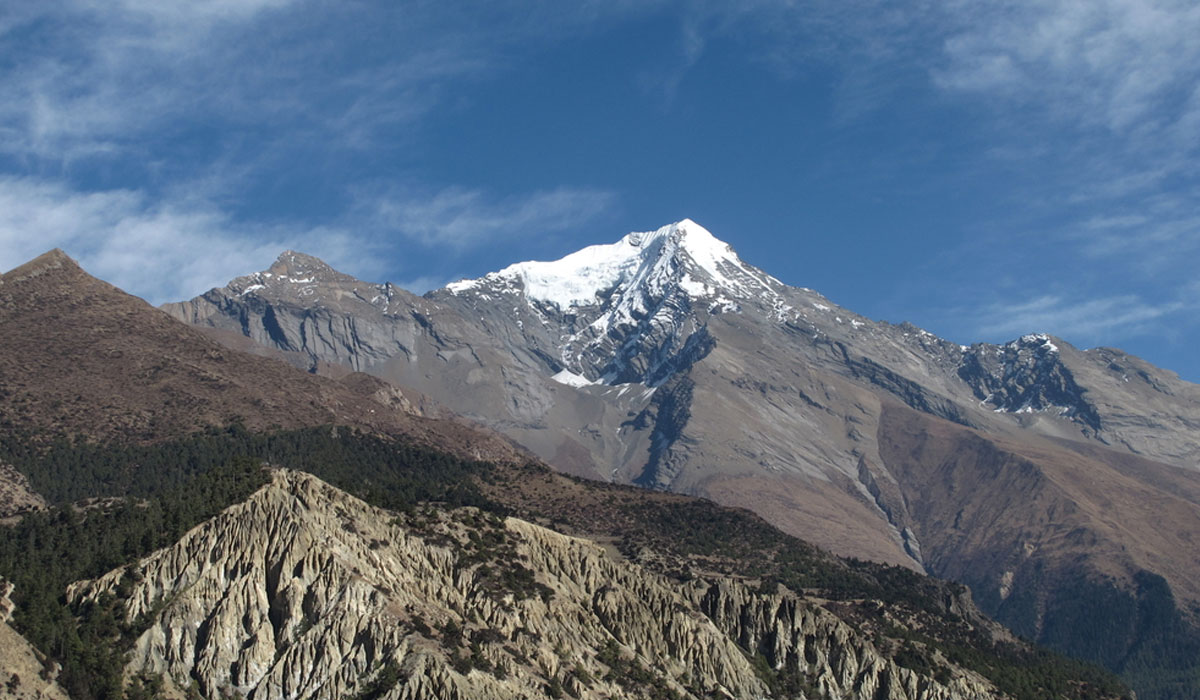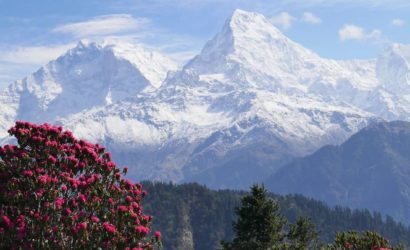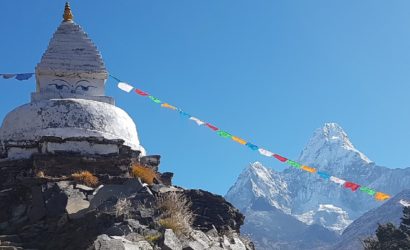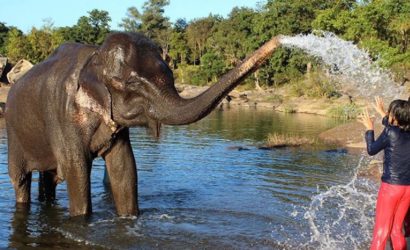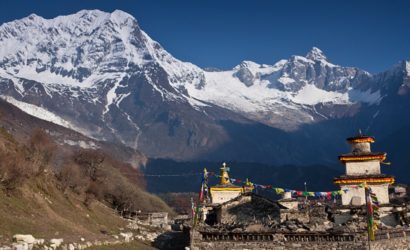Pisang Peak stands at elevation of 6091 meters up above from Pisang village in Annapurna Himalaya range and yak pastures in a uniform slope of ice and snow to the final summit pyramid. Pisang Peak climbing is considered one of the busy climbing peaks among the trekking peaks in Nepal.
To reach the base camp from Pisang village, the path ascends through sparse wood and pasture to a Kharka at 4420 meters, which is considered the best place for setting up the base camp. High camp is set up at 5450 meters, climbing to a shoulder on the South-West Ridge. There will be snow at the high camp from the end of November to the end of March.
The well-defined ridge leads to the final snow slop, which is quite steep but not difficult to reach the summit. Descent is made on the same route. The peak summit offers a truly beautiful view of the Annapurna group, including Tilicho Peak, Annapurna II and IV, Gangapurna and the Glacier Dome.
After the your main adventure of Pisang Peak climbing leads to Thorong La pass (5416 meters), through Manang, Yak Kharka, which are the main attraction of whole Annapurna Circuit trek. Due to the difficulties of crossing the pass, the circuit is usually walked in a counter clockwise direction.
We start our trek towards the Manang Valley after the successful summit and cross the world’s highest pass, the Thorong La Pass early in the morning, and arrives at Muktinath, another part of Annapurna.
From there we go to Jomsom, Mustang’s capital, with a small airstrip on the bank of the Kaligandaki River.
Taking a bunch of Himalaya experience, Pisang Peak climbing journey will end at the Jomsom, for a Jeep drive/flight to Pokhara in the early morning.
Pisang Peak Climbing Difficulty
This majestic mountain peak is located in Pisang, district of Manang, in the northern part of Nepal. It is situated between Annapurna and Manaslu. This is a popular climb as it provides great opportunities for discovery and climbing adventures. It is famous because it is easy to climb. Though, the summit ridge is little bit technical. The pyramid like summit of Pisang Peak lies on a way to the world’s highest pass: Thorong La Pass. And it also represents the taste of Annapurna Circuit Trek to some extent.
Pisang Peak Climbing grades PD+, which means ‘Per Difficulty’ walking on certain parts of climb on rocks and glaciers which have technical difficulties.
The following are some of the major factors that specify the difficulty level on the Pisang Peak:
- The distance you cover during your entire trip
- Weather conditions of the location you are climbing to
- Your Physical Fitness
- Highest points of the peak Altitude sickness
- Basic Mountain climbing training
When is the best time to climb Pisang Peak?
Generally, Pisang Peak can be attempted year round. People have successfully summited Pisang peak even during the winter, however cold weather could be unfavorable to some, mainly if you are a beginner mountaineer. It is not that the mountain is technically difficult to climb, but it depends more on how confident you are with the winter months extremes.
While the peak can be climbed almost year-round, during spring (March to early June) and autumn (September to November) are the best and most suitable time to climb the Pisang Peak.
The weather appears to be clearer during autumn in Nepal, and it is by far the most popular time to climb the peak and high passes. Also, this is the best time to visit Nepal in general, and this time is when most tourists choose trekking and mountaineering in Nepal.
After the monsoon season can often get a bit crowded, but you can be pretty sure on the flip side that you will have the best weather conditions and climbing conditions.
I have never climbed peak before, can I go for peak climbing in Nepal?
There’s always a first time for everything, including peak climbing. This is a non-technical peak, which a fit trekker can climb safely, and even somewhat technical peaks can be attempted by a beginner climber with a professional native Sherpa climbing guide.
Getting Pisang Peak Climbing
Drive from Kathmandu to Dharapani via Besisahar, we start our expedition and follow the famous Annapurna Circuit Trek trails and in 3 to 5 days we will reach Pisang village.
We at Himalaya Discovery glad to guide you Pisang Peak expedition with our native experienced Sherpa guides and expert team for a complete Himalaya experience.
Upon your arrival in the Kathmandu airport after completing your custom formalities Visa, etc. pick up your luggage and look for our airport representative from Himalaya Discovery Adventures, who will display your name on the board at the arrival gate. You will be greeted by our representative and transferred to the hotel by private tourist vehicle. Overnight in Kathmandu.
Today is free for sightseeing in Kathmandu. You may wish to visit Durbar Square in the heart of the old city where the old Royal Palace, with its intricate woodcarving is located. The whole area is a maze of temples and images. Leading away from the square in all directions are narrow alleys, full of the most amazing variety of shops and stalls. Some of these landmarks are considered World Heritage Sites including the historic Bhaktapur Durbar Square, the famous ‘Monkey Temple’ Swayambhunath and Buddhists shrine Buddhanath which is one of the largest Stupas in the world.
There will also be a full trip briefing today with gear check. In case you need to hire or buy equipment locally there will be time to do this today. Overnight in Kathmandu.
After breakfast we begin our drive to Dharapani. It’s a long journey through beautiful townships in Nepal. Our trail is next to the flowing Trishuli River during the start of our journey. We also pass through Pokhara, popularly known as Lake City, before arriving at Dharapani, one of the Manang Valley’s largest villages. Dharapani overnight Overnight at guesthouse.
Today, along with several landslides, we are negotiating a few steep forest ridges on the road to Chame. Nevertheless, we should not forget to look up, as we will be welcomed by the stunning views of Lamjung Himal, Annapurna II and Annapurna IV (7,525 m). We also find small hot springs that are supposed to help us relax for a while. Chame overnight. Overnight at guesthouse.
A narrow steep path through a very dense pine forest will bring us to a dramatic curved rock face, rising 1500 m from the river. Overnight at guesthouse.
Today we spend a day acclimatizing in Pisang. The whole day we spend doing some fine day walks and over viewing the magnificent views around the village & the day time is best to gain altitude. At the end of the day, we return back to our accommodation & have a night rest, Overnight at guesthouse.
The trail is steep ascent passing through Upper Pisang. En route you cross forests of pine and local vegetation. The views of Annapurna rang welcome you. From today the accommodation will be tented camp for few days and you will be having camp food cooked by our professional cook, Overnight at tented camp.
Today the trek leads along rocky glacier path to High Camp. You will be completely charmed by the panoramic views of Annapurna range, Chulu East, Chulu Far East, Nawal peak, Tilicho peak and many other unnamed mountains and peaks, Overnight at tented camp.
Today is our main adventure day, we start early in the morning to climb Pisang peak but it all depends on the weather condition. At the summit of Pisang peak, you can have closer panoramic views of Annapurna range, Chulu East, Chulu Far East, Nawal peak, Tilicho peak, Manaslu, Ganesh Himal, Tibetan mountains, Kang Guru Peak, Gyaji Kang peak, Tilje peak, Kuchubhro peak and many more. After a safe trip to the top we safely make our way down to base camp, Overnight at tented camp.
The trail is steep ascent passing through Upper Pisang. En route you cross forests of pine and local vegetation. The views of Annapurna rang welcome you. From today the accommodation will be tented camp for few days and you will be having camp food cooked by our professional cook, Overnight at tented camp.
From the Pisang peak base camp we trek towards the village of Pisang. There are two routes from Pisang to Manang. We choose the one that passes through Geru via Upper Pisang as it guarantees exceptional views of Mt. Annapurna, Pisang Peak, and others.
The weather gets colder and drier as we walk near Manang. Nevertheless, we should be cheered by a short visit to Barge Monastery, Manang District’s largest monastery. Overnight at guesthouse.
From Manang village, the trail crosses a river, climbs to Tenki village above Manang, and then climbs from the Marshyangdi Valley northwest to the Jarsang Khola Valley. The trail follows this valley to the north, passing a few pastures, a forest of juniper trees as it gains elevation gradually. Close to the small village of Ghunsa, a cluster of flat mud roofs just under the trailhead, the trail continues.
Now the trail crosses meadows where horses and yaks are grazing. The trail passes an ancient old Mani wall in a pleasant meadow after crossing a small river on a wooden bridge and then reaches another small village of Yak Kharka. Overnight at guesthouse.
Thorang Phedi is an uphill walk. We cross a suspension bridge after walking for some time and reach the village of Ledar. We ascend higher and go through towering cliffs before reaching Thorang Phedi, the last village before Thorong La. On this journey we are rewarded with one of Mt. Gundang, Mt. Syagang, Thorung Peak and Mt. Khatungkan’s best views. Overnight at guesthouse.
Crossing Thorong La Pass, our ultimate goal today will be one of the highest passes in the world. We’re going to cross the easiest and safest path pass from east to west (Manang to Muktinath). We walk up the mountain about three in the morning.
We realize that our journey was worth it when we finally make it to the top. Until leaving for Muktinath Valley at the foot of the Thorong La Pass, we can take a few photos. We continue our trek to Muktinath, which for both Hindus and Buddhists is an important place of pilgrimage. Overnight at guesthouse.
For both Buddhists and Hindus, Muktinath is an important pilgrimage site. We visit the temple area in the morning and a Buddhist monastery near the temple. We continue our trek to Jomsom after the short tour, which is popular because of its sweet apples and strong winds.
In fact, even Nepalese songs pay tribute to the strong gush of wind blowing around noon in Jomsom. After reaching Jomsom, we can visit its Ecological Museum, which provides information on the rich culture of Jomsom as well as the valley-born flora and fauna. Overnight at guesthouse.
Today, we fly in the earliest possible airplane to Pokhara, the lake city. We can take a rest after check-in at our hotel or visit the lakeside area near the Fewa Lake. Here we can buy some souvenirs or taste some local delicacies.
We say goodbye to Pokhara’s beautiful lake city after breakfast and drive to Kathmandu. We have the rest of the day off after reaching Kathmandu. There will also be an evening farewell dinner hosted by Himalaya Discovery to celebrate our successful completion of our journey.
Our Nepal adventure is coming to end today! A representative from Himalaya Discovery will escort you to the airport about 3 hours before our scheduled flight. We have plenty of time on our way home to prepare our next adventure in Nepal’s beautiful country.

